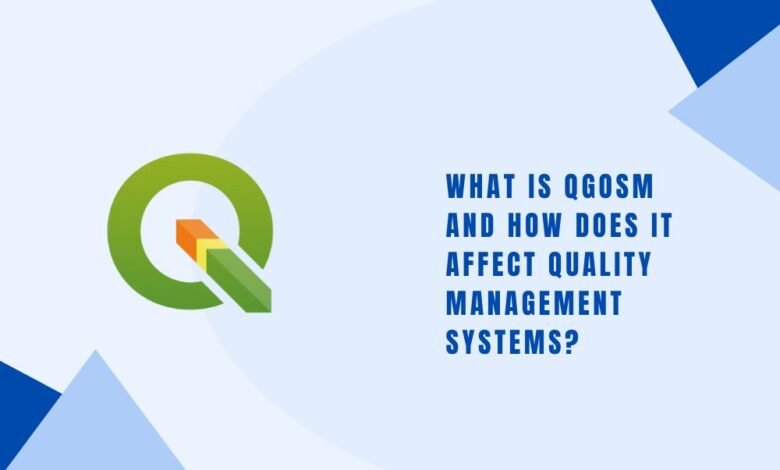
Quality management systems (QMS) play an important role in ensuring that businesses provide consistent, high-quality products and services to their customers. But what tools or standards do companies use to ensure their QMS is effective? One of the key frameworks used for this purpose is QGOSM.
In this blog, we will dive into what QGOSM is, how it influences quality management systems, and why businesses should pay attention to it.
What Is QGOSM?
Understanding the Basics of QGOSM
QGOSM stands for Quality Global Organizational Standards Management. It is a framework used to help companies maintain and improve their quality management systems. This system focuses on setting global standards that companies can follow to ensure their operations are efficient, consistent, and of high quality.
The goal of QGOSM is to provide businesses with clear guidelines that help them meet the expectations of their customers while complying with legal and regulatory requirements. By using QGOSM, companies can create a structured approach to managing their processes and delivering better products and services.
What Makes QGOSM Important?
QGOSM is important because it helps businesses stay competitive. Companies that follow this framework can maintain high-quality standards, improve customer satisfaction, and reduce operational errors. Additionally, QGOSM provides a structured approach to quality management, making it easier for businesses to identify areas for improvement and ensure they are compliant with global standards.
How Does QGOSM Work?
The Key Components of QGOSM
To understand how QGOSM works, it’s essential to look at its key components. These components help guide companies in managing their quality processes effectively:
1. Planning and Strategy
The first component of QGOSM is planning and strategy. This involves setting clear goals and objectives for the company’s quality management system. Businesses need to identify what they want to achieve in terms of quality and create a plan to reach these goals. This might involve improving certain processes, reducing product defects, or increasing customer satisfaction.
2. Process Control
Process control is another key element of QGOSM. This involves monitoring and controlling the various processes within the business to ensure they are operating smoothly and efficiently. By having control over these processes, companies can reduce the chances of errors and improve overall performance.
3. Documentation and Record Keeping
A strong quality management system relies on accurate documentation and record-keeping. QGOSM emphasizes the importance of keeping detailed records of all business activities related to quality. This ensures that companies can track their progress, identify any issues, and demonstrate compliance with standards.
4. Continuous Improvement
Continuous improvement is a core principle of QGOSM. Businesses are encouraged to always look for ways to improve their processes and quality standards. This might involve adopting new technologies, training employees, or revising current procedures to make them more effective.
Implementing QGOSM in a Business
Implementing QGOSM involves several steps. The first is to assess the current quality management system in place. Companies need to evaluate their existing processes, identify areas for improvement, and set clear goals. Once this is done, the business can begin aligning its operations with the QGOSM framework.
Training employees is another important step in implementing QGOSM. Staff need to understand the principles of quality management and how QGOSM helps the business achieve its goals. This ensures that everyone in the organization is working towards the same objective—maintaining high-quality standards.
How Does QGOSM Affect Quality Management Systems?
Setting Global Standards
One of the primary ways QGOSM impacts quality management systems is by setting global standards. These standards provide businesses with a clear framework for how they should manage quality within their organization. This is especially important for companies that operate across multiple countries, as it ensures that quality standards are consistent across all regions.
International Compliance
QGOSM helps companies meet international standards and regulations. For businesses operating globally, it’s crucial to comply with the laws and standards of different countries. QGOSM provides a framework that can be applied worldwide, ensuring that businesses can meet these requirements no matter where they are located.
Improving Efficiency and Reducing Costs
A well-implemented QGOSM framework can help businesses improve efficiency by streamlining processes. When a company has clear procedures and controls in place, it can reduce operational errors and avoid costly mistakes. This not only leads to better-quality products and services but also lowers costs associated with waste, rework, and customer complaints.
Reducing Defects and Errors
QGOSM emphasizes process control and continuous improvement, which helps businesses reduce defects and errors in their products and services. By constantly monitoring and refining their processes, companies can catch issues early and make adjustments before they lead to larger problems. This reduces the risk of defective products reaching customers and enhances overall quality.
Enhancing Customer Satisfaction
In today’s market, customer satisfaction is more important than ever. QGOSM helps businesses improve their products and services, which in turn enhances customer satisfaction. When customers receive high-quality products that meet their expectations, they are more likely to return and recommend the business to others.
Building Trust and Reputation
By consistently meeting high-quality standards, companies can build trust with their customers and improve their reputation in the market. A strong reputation for quality can lead to increased business opportunities and long-term success.
The Role of Technology in QGOSM
Using Technology for Better Quality Management
Incorporating technology into quality management systems can greatly enhance the effectiveness of QGOSM. Modern tools like data analytics, automation, and software solutions allow businesses to monitor their processes in real-time, track performance, and identify areas for improvement more easily.
Data-Driven Decision Making
Technology allows businesses to collect and analyze data related to their quality processes. This data can be used to make informed decisions about where improvements are needed, how to address issues, and how to optimize overall performance.
Automating Processes for Efficiency
Automation is another key benefit of using technology in QGOSM. By automating repetitive tasks, businesses can reduce human error and save time, allowing employees to focus on more complex tasks that require critical thinking and decision-making.
Challenges of Implementing QGOSM

Overcoming Resistance to Change
One of the biggest challenges businesses face when implementing QGOSM is resistance to change. Employees may be accustomed to working in a certain way, and adjusting to a new framework can be difficult. It’s important to provide clear communication and training to help employees understand the benefits of QGOSM and how it will improve their work.
Costs of Implementation
Another challenge is the cost of implementing QGOSM. While the long-term benefits of QGOSM often outweigh the initial costs, setting up new processes, training staff, and integrating technology can be expensive. However, businesses that invest in QGOSM often see significant returns in terms of improved quality, reduced waste, and higher customer satisfaction.
Maintaining Continuous Improvement
Continuous improvement is a core principle of QGOSM, but it can also be challenging to maintain over time. Businesses must remain committed to regularly evaluating and refining their processes to ensure that they continue to meet the highest quality standards. This requires ongoing effort and investment in both people and technology.
Conclusion
QGOSM is an essential framework for businesses that want to maintain high-quality standards and remain competitive in the global market. By setting clear guidelines for quality management, QGOSM helps companies improve their processes, reduce defects, and enhance customer satisfaction. While implementing QGOSM can come with challenges, the long-term benefits make it a worthwhile investment for businesses of all sizes.
Note:- To read more articles visit on toastul.